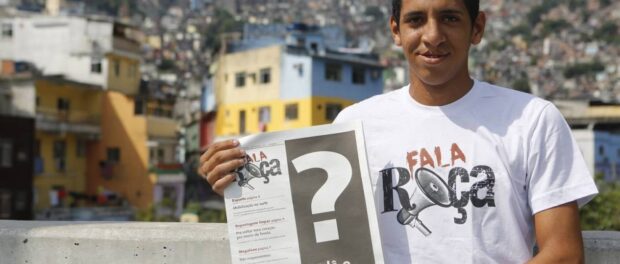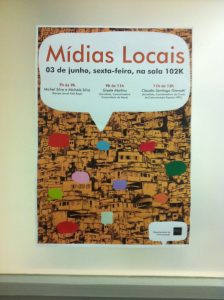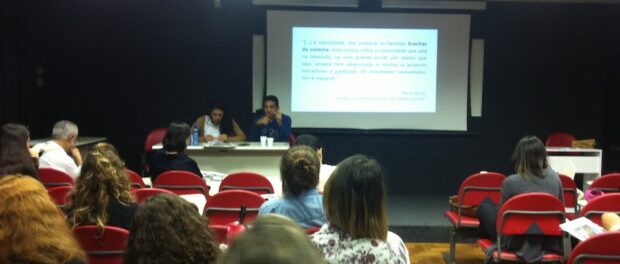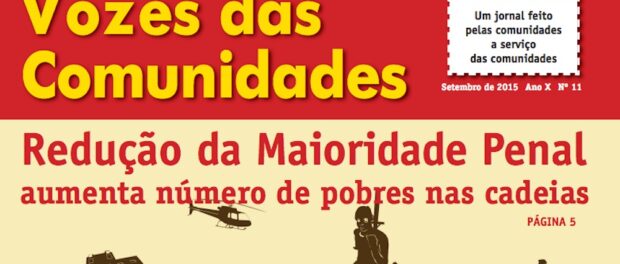
On June 3 the Communications Faculty at the Pontifical Catholic University of Rio de Janeiro (PUC) brought together a group of favela journalists to take part in a “Morning of Local Media” lecture series. Michele and Michel Silva, siblings from Rocinha and founders of Jornal Fala Roça and Viva Rocinha, Gizele Martins, a journalist with O Cidadão from Complexo da Maré, and Claudia Santiago Giannotti, the coordinator of a popular communication course at Núcleo Piratininga de Comunicação, all addressed a crowd of about one hundred people on the importance of favela residents reporting on their own stories and lives.
Community Communication
 The speakers all emphasized the value of empowering favela residents to engage in community communication, which establishes favela residents as the content-generators and narrators in their own stories. When favela residents engage in journalism, photography, filmmaking, music, and generally express the lives of their fellow residents for other residents, this is community communication. As Martins told the PUC crowd, “community communication recognizes the value of our lives, it is a creation of our identity.” Furthermore, homegrown networks of expression are those that most effectively get messages across to the entire community.
The speakers all emphasized the value of empowering favela residents to engage in community communication, which establishes favela residents as the content-generators and narrators in their own stories. When favela residents engage in journalism, photography, filmmaking, music, and generally express the lives of their fellow residents for other residents, this is community communication. As Martins told the PUC crowd, “community communication recognizes the value of our lives, it is a creation of our identity.” Furthermore, homegrown networks of expression are those that most effectively get messages across to the entire community.
Martins explained how instead of going in to a community and deciding what is appropriate communication, “you have to accept how favelados already communicate.” She showed documentary films created by residents and emphasized how the film creators, protagonists, and even soundtrack artists were all favela residents communicating in ways that suited the needs of their community. She provided the example of funk as a revolutionary form of music that acts as a living cultural museum as well as a means to communicate in spite of literacy barriers.
In an effort to promote community journalism, Claudia Santiago Giannotti created a journalism course for favelas in which interested residents develop the practical skills to report on their own lives. From the course, the online journal Vozes das Comunidades emerged as a platform to publish the work of each year’s group of students in an annual magazine available online. The platform explains that students are “residents of favelas or occupations, diverse social militants, journalists, students and others interested in building community communication, which gives voice to those who normally don’t have space in traditional forms [of media].”
Similarly, Gizele Martins developed Favela Fala, a two-month course on community communication for residents of Maré. She disputes the notion that because some favela residents can’t read, they can’t communicate: “To communicate is a human right. Favela Fala is a course happening tomorrow and it will prove how all can communicate.”
As Michele and Michel Silva have also created workshops through Fala Roça to support young aspiring journalists in their community, these journalists collectively demonstrate a trend in favela journalism for participants to support others in joining the field. This both offers new opportunities to individuals and strengthens entire communities by empowering a plurality of previously marginalized voices.
Challenges and strategies
The panelists also spoke about challenges community communication encounters such as censorship and threats, funding shortages, and the simple fact that not yet all their potential readers or followers have regular Internet access, although one study suggests favela residents are more technologically connected than the average Rio resident. However, in true favela spirit community journalists are resourceful entrepreneurs and have found tactics to overcome these difficulties. As Michele Silva put it, “when you have contact with the other side of the story, you can’t keep quiet.”

Online platforms may be limited to those favela residents with Internet access, but digital media is also a cost-effective way to publish a lot of content and communicate quickly with an ever-growing network of people. The team behind Viva Rocinha also decided to print limited hard-copy publications of their online newspaper to accommodate residents without Internet.
Michele Silva addressed some of the complications of securing funding without compromising the integrity of a community newspaper. She said: “We have to put logos on various shirts but today we are already thinking of how we can use the funds we have to make the most without selling our souls. We are always trying to lower our costs because needing money from NGOs also comes with a mountain of strings attached.” By using community advertisers and maintaining a digital presence and workspace, Fala Roça is able to keep costs down.
Documenting the documenters
Towards the end of the lecture series, Claudia Santiago Giannotti and Gizele Martins shared their co-authored book, Experiências em Comunicação Popular no Rio de Janeiro Ontem e Hoje (Experiences in Popular Communication in Rio de Janeiro Yesterday and Today), published on May 10 and documenting the history of resistance through communication in Rio’s favelas. Experiências em Comunicação Popular provides in-depth context to the grassroots work that has inspired many favela journalism projects and includes case studies on numerous community communication groups in favelas.

